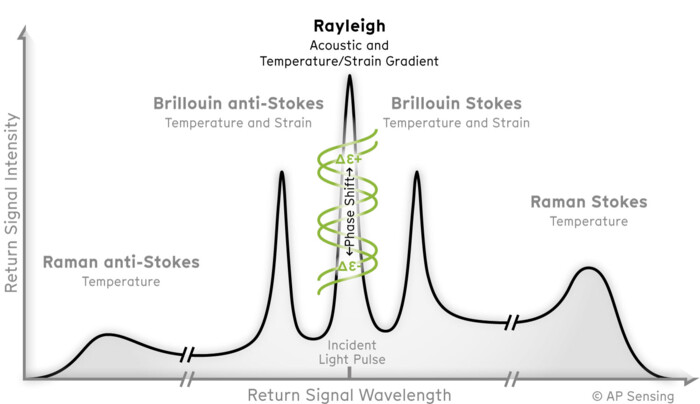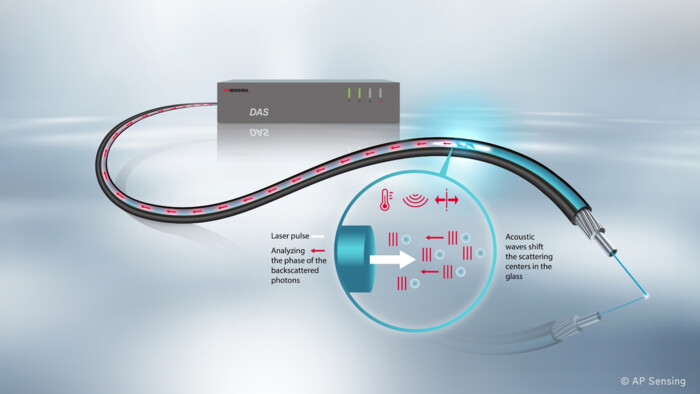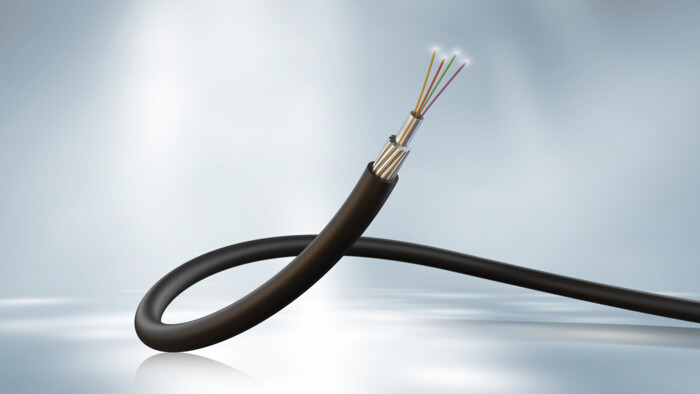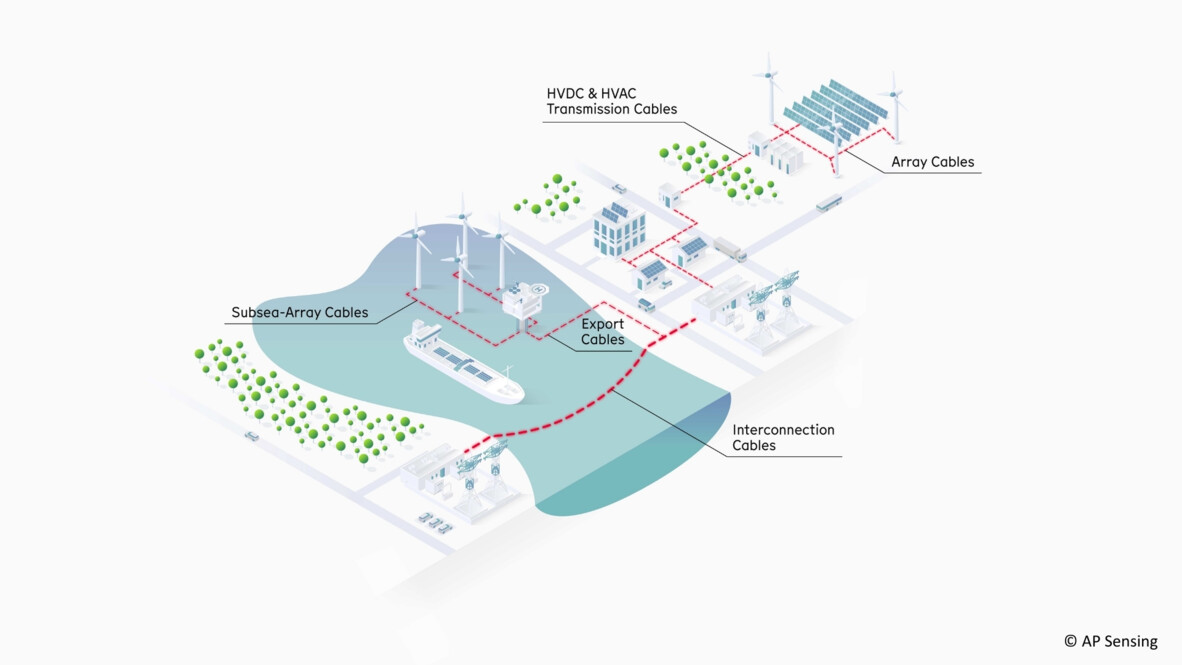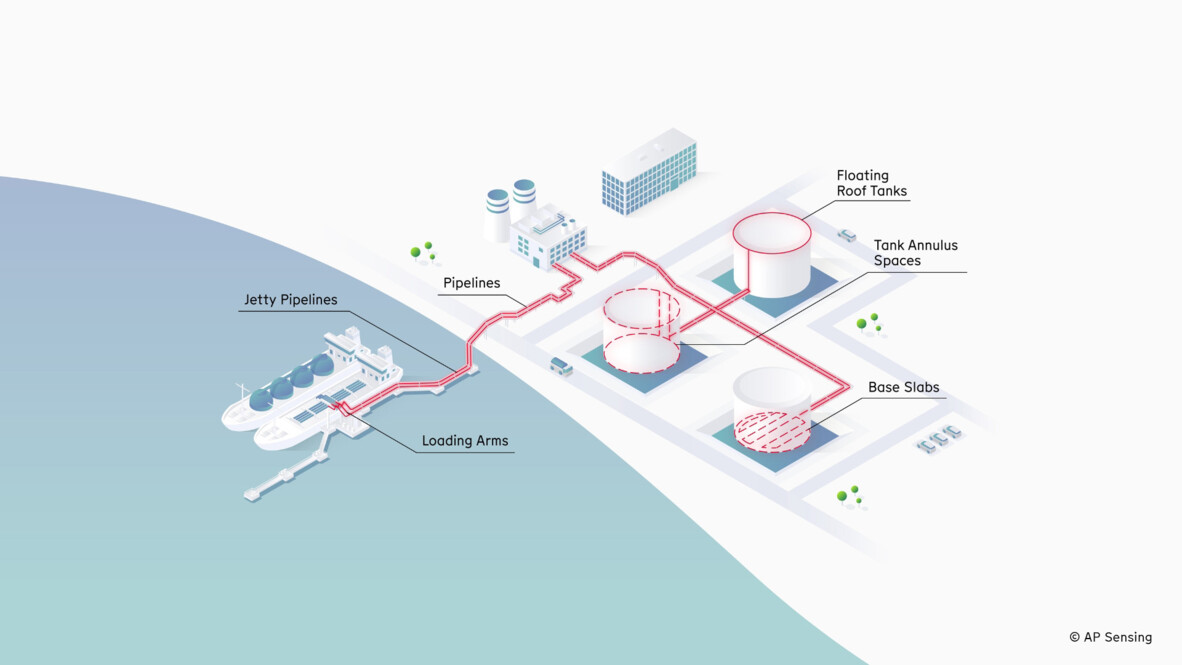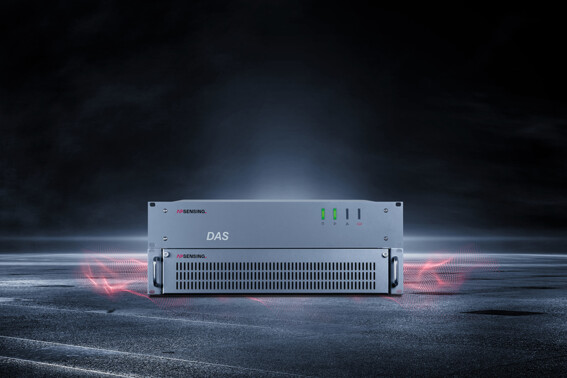Distributed Acoustic Sensing (DAS) systems detect strain changes and vibrations along optical fibers. This highly sensitive technology is used for monitoring critical infrastructure such as power cables, pipelines, or railroad tracks. The fiber optic cable functions as a distributed acoustic sensor, providing continuous measurements along the entire length of the cable, and allowing operators or automated systems to make informed decisions and take preventive or corrective actions in a tailored way. Classification algorithms based on ML/AI are used to detect, identify, and locate events such as pipeline leaks, power cable faults, and intrusion activities.
With DAS technology laser pulses are sent from an interrogator through the optical glass fiber. Part of the light wave is scattered back (Rayleigh backscattering), as the light waves interact with natural microscopic inhomogeneities in the glass. These inhomogeneities follow environmental acoustic vibrations reaching the fiber. The Rayleigh backscattering keeps the wavelength of the stimulating pulse, but with a particular shift of the wave’s phase. This phase carries valuable insights about the acoustic signals, which are then interferometrically analyzed.
Strain or acoustic amplitude are quantified along a selectable gauge length (e.g., 5 meters), indicating the rate of strain change over that interval of fiber per location along the entire fiber.
The previous laser pulse needs time to travel the full length of the fiber and for its scattered part to return before the next pulse can be transmitted. Hence, the maximum pulse rate is determined by the length of the fiber. For example, a 20-kilometer fiber typically allows a rate of 5,000 pulses per second. This allows acoustic signals to be probed at that rate, with frequencies up to the Nyquist frequency, which is half of the pulse rate, being unambiguously resolved. Higher frequency components are also measured but become ambiguous due to Nyquist aliasing.
Since higher acoustic frequencies experience greater attenuation in matter, most relevant frequencies for detecting and classifying events are in the lower of the 2 kHz range.
In the very low frequency range (some Hertz and below), phase-based C-OTDR systems enable highly sensitive measurements of transient temperatures (i.e., changes in the 0.001 °C range) due to the elongation/compression of the fiber with temperature changes. This measurement mode is called Distributed Temperature Gradient Sensing (DTGS) and is widely used in the oil & gas industry.
AP Sensing's Proprietary 2P Squared Technology
With the combination of phase and amplitude measurements, AP Sensing's proprietary 2P Squared technology is less affected by the fading signal commonly observed in other C-OTDR systems. AP Sensing's DAS system provides more constant performance over the entire fiber, resulting in a high measurement quality. Excellent raw data is the basis for pattern recognition and machine learning algorithms.
Key features of AP Sensing's 2P Squared DAS technology include:
- Accurate measurement and location of the amplitude, frequency, and phase of the incident acoustic field
- True linearity maintained across the entire distance, time, and acoustic amplitude
- Signal quality achieved with excellent signal to noise ratio
- Advanced “2P Squared” optical techniques improve signal quality over long measurement ranges
- Measurement range of over 100 km
The Role of the Optical Fiber in Distributed Acoustic Sensing
There are a variety of optical fiber types on the market serving various requirements mainly in telecommunication installations. Most of these types are suitable for use with DAS; often the best choice are standard single mode fibers like G.652, G.655 or G.657. Single mode fibers offer low attenuation over distance, thus allowing long sensor length (100 km and beyond), and have no mode dispersion, which would degrade the pulse shape and signal quality over distance. Due to wide use, standard single mode fibers are available at very low cost. As the applications of Distribute Acoustic Sensing continue to grow rapidly, so does the availability of fibers optimized for specific sensing requirements. If the required sensing distance approaches or exceeds 100 km, the inherent fiber loss of the probing pulse and backscatter limits the signal-to-noise (SNR) ratio of the measurements.
Ultra Low Loss Fibers (ULL)
ULL minimize the fiber attenuation with values around 0.15 dB/km (at 1550 nm) compared to standard fiber, which typically has about 0.2 dB/km. ULL fibers have a smaller Rayleigh backscatter coefficient, resulting in reduced signal amplitude at short distances compared to standard single mode fiber. However, at greater distances like 70 km, the effect of lower attenuation becomes dominant beyond a break-even distance, depending on the specific fibers used.
Enhanced Fiber (EF)
EF, on the other hand, is designed to increase the backscatter signal through weak reflectors inscribed in the fibers using femto-second lasers. This enhancement typically boosts the signal by 10 to 20 dB compared to natural Rayleigh backscatter, i.e. making the backscatter signal up to 100 times stronger. EF has an increased attenuation, so feasible fiber lengths are shorter.
Combining ULL and EF
Combining ULL and EF leverages the advantages of both types, allowing for extended reach with ULL fiber and adding more kilometers by appending enhanced fiber. A reach of 125 km has been demonstrated with such a combination using a standard DAS interrogator, without any optical amplification along the sensor.
Benefits & Advantages of Distributed Acoustic Sensing
Distributed Acoustic Sensing (DAS) offers many advantages for monitoring critical infrastructure including:
Simplicity & Robustness of the Sensor
A standard single glass fiber integrates all fundamental elements of a sensor: supply of energy to the sensor (the light pulses), the sensor itself (the fibers inhomogenity, see above), the exact location thanks to the distributed measurement principle; and information transport (the light returning to the instrument). Hence the fiber is the ideal media to act as a sensor, simply by connecting it to the interrogator unit.
When integrated in robust cables, fibers are reliably protected for decades in the field application. The typical service life of such cables is around 40 years.
Continuous Monitoring & Early Warning
DAS provides continuous and real-time monitoring along the entire length of the optical fiber. This allows for early detection and localization of threads to the asset (e.g. an excavator digging close to a pipeline or burried power cable) or degradations of the assets, enabling timely intervention and preventive maintenance. By detecting subtle changes or abnormalities in infrastructure conditions, DAS systems enable proactive maintenance and the avoidance of costly downtime or failures.
High Location Accuracy
AP Sensing’s DAS offers high location accuracy in the meter range, even over long distances up to 100 km. This means that the system can precisely detect and locate events or disturbances along the fiber optic cable within meters. It allows for accurate pinpointing of issues, even in large and complex infrastructure networks. Events can be mapped to the asset schematically by using AP Sensing’s SmartVision software.
Long Sensing/Monitoring Range
Depending on the sensing requirements fiber optic sensors can cover distances beyond 100 km, making DAS systems suitable for monitoring vast stretches of infrastructure, such as pipelines, railways, or power transmission lines, with minimal infrastructure requirements.
Multi-Parameter Sensing
Distributed fiber optic acoustic sensing systems respond to various parameters, including acoustic signals (such as vibrations or sounds), changes in temperature, strain, and pressure. This multi-parameter sensing capability provides comprehensive monitoring and enhances the ability to detect and identify different types of events or anomalies.
Cost-Effectiveness
Distributed Acoustic Sensing technology uses simple fiber optic cables and can even leverage existing fiber optic cables, reducing the need for additional hardware and installation costs. This makes DAS systems a cost-effective solution for long-term monitoring of infrastructure.
Remote Monitoring & Difficult-to-Access Areas
DAS systems can be monitored remotely from a centralized control center, allowing for real-time data analysis, event detection, and response. Such remote monitoring capability enables rapid decision-making and response to critical events, enhancing overall operational efficiency and safety.
DAS can be deployed in difficult-to-access areas, which allows for remote monitoring and surveillance in locations where traditional sensors may be challenging or impractical to install. That enables the monitoring of critical infrastructure such as pipelines, railways, and borders without the need for extensive infrastructure or frequent maintenance visits.
Robustness & Safety in Hazardous Zones
Fiber optic cables used in C-OTDR (DAS) systems are suitable for harsh environmental conditions, such as those encountered in outdoor or industrial settings. AP Sensing’s system offers maximum reliability, even under severe conditions including dirt, dust, corrosive atmospheres, high humidity, extreme temperature changes, solvent vapors, radioactivity, explosive environments due to gas or dust (ATEX/IECEx), and electromagnetic interference.
Fiber optic cables are inherently immune to electromagnetic interference (EMI), making them safer in environments where electrical equipment poses a risk of ignition or explosion. Additionally, as DAS systems can be deployed over long distances without the need for frequent access points, this reduces the need for personnel to enter hazardous areas.
Use Cases of DAS systems
Distributed Acoustic Sensing technology is used for monitoring infrastructure as well as detection and localization of events, including:
- Third party interference/intrusion (TPI) activities affecting power cables (onshore and offshore), pipelines, railways, and perimeter security
- Power cable condition monitoring and network optimization
- Power cable faults, bottlenecks, or abnormalities
- Power cable sheath current monitoring/fiber-based current monitoring
- Pipeline leaks
- Pipeline inspection gauge (PIG) tracking
- Well & reservoir monitoring
- Seismic profiling
- Large-scale structural health monitoring
- Railway monitoring
Additionally, DAS is under constant evolution, with new applications including:
- Earthquake monitoring
- Landslide-monitoring as a part of early-warning system
- Integration into smart city infrastructure.
- Mineral resource exploration
- Further applications in the renewable energy sector
AP Sensing's DAS System
DAS N51/N52-Series
Enhanced performance and measurement capabilities for protecting your valuable assets and infrastructure. Our fifth generation DAS features a world-leading measurement range for true phase-based systems without requiring additional amplification. It provides improved measurement performance with enhanced usability and reduced signal artifacts such as fading.
How Does Distributed Acoustic Sensing ‘Measure Up’ Next to Other Sensing Technologies?
Conventional Strain and Acoustic Sensors
Conventional sensors such as electrical strain gauges or hydrophones have long served as the foundation of acoustic sensing. However, larger assets in particular require more complex infrastructure such as power supply and signal transmission lines, compared to a simple passive glass fiber used with DAS technology.
While point sensors such as strain gauges offer high sensitivity at specific locations, they lack the ability to continuously monitor entire lengths of infrastructure, kilometers long, in real-time. DAS systems, however, provide continuous monitoring over long distances without the need for multiple sensors.
Fiber Optic Point Sensors
Fiber optic point sensors, such as fiber Bragg gratings (FBGs) are limited by their fixed sensing point locations along the fiber. Strain and vibrations are captured only at the upfront defined sensor locations, where gratings need to be written into the fiber, while being insensitive at all other fiber locations. Usually, the number of sensor points is relatively limited. DAS systems, with their distributed sensing capability, offer much higher spatial resolution and coverage. This makes them more suitable for monitoring applications where detailed spatial information is required.
With a proven track record and continued innovation, AP Sensing offers a completely integrated, end-to-end solution made in Germany. Our team works together with you to select the right combination of technologies to fit your requirements.
Key Takeaways
Distributed Acoustic Sensing technology is revolutionizing the field of surveillance and monitoring, with a wide range of applications including power cable, pipeline, and well & reservoir monitoring.
DAS utilizes a fiber optic cable as a continuous sensor by capturing acoustic/vibrational data along an entire asset. Classification algorithms are used to detect and locate events such as leaks, cable faults and intrusion activities, which offers a comprehensive, versatile sensing solution with benefits including continuous monitoring over long distances, high spatial resolution, and early warning/preventative maintenance. This assists system operators in monitoring assets 24/7 and taking swift, imperative action in emergency situations.

